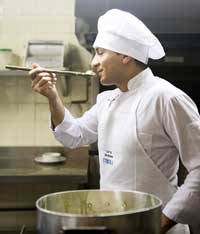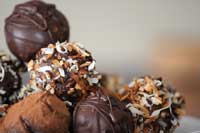The perfect meal Understand article
Psychology is teaching us how to make food sweeter without changing its ingredients.

perfect meal they don’t just
need to work in the kitchen.
Image courtesy of Gobierno de
la Ciudad de Buenos Aires /
Wikimedis Commons
Normally it might be considered rude to take your mobile phone out at the dinner table, but at London-based restaurant House of Wolf, diners used their phones as part of an experiment into ‘sonic seasoning’. Inspired by research led by Charles Spence, a psychologist from the University of Oxford, UK, the restaurant invited diners who had been served a dessert of ‘cinder toffee lollies’ to use their mobile phones to ring one of two numbers. On one phone line was music chosen to enhance the sense of sweetness; on the other, a tune to bring to mind a feeling of bitterness. This helped each diner to alter their perception of the dessert and enjoy it more. “It seems we associate higher notes, such as a tinkling piano, with sweetness, and deeper, more resonant tones with bitterness,” says Charles.
The simple experiment encourages diners to flick between high- and low-pitched sounds as they enjoy a delicious bittersweet snackw1. Try it with your class, perhaps with a toffee, and if you happen to experience sweetness flooding over your taste buds as you listen to the high notes, or bitterness as the pitch gets lower, you are not imagining things. The music has changed your perception of flavour, or at least prompted your brain to alter how it perceives the snack.
This tasty exercise illustrates one of many approaches that Charles’s team, in collaboration with neuroscientists, marketers, musicologists, designers and chefs, are using to better understand our experience of food and drink. “Flavour is shaped not only by taste and smell, but also by the environment, the context of the meal and visual cues,” he explains. “Food is the one place where all the senses come together. The room, the music played, even the shape and colour of your plate – they all matter.”
Sensory science

when it’s round.
Image courtesy of David
Leggett / Wikimedia Commons
Charles’s publication list reads like an experimental tasting menu. In one study, designed with top Spanish chef Ferran Adria, diners rated an identical strawberry mousse as 10% less sweet if it was served on a black plate rather than a white one. Another illustrated how perceptions of whisky taste can be influenced to be grassier, woodier or sweeter, by changes in lighting, background noise or surrounding scents. Woody notes, for example, are enhanced by low mellow lighting, whereas red lighting and a rounded glass can make your drink taste sweeter.
Charles has also investigated why tomato juice is a drink of choice on an aeroplane but not on the ground (Spence et al, 2014), and found that potato chips that sound crunchier taste better. It seems that what we enjoy depends not only on our taste buds but also on our minds. “Even before we put food into our mouths, our brains have made a judgement about it,” explains Charles. “People buy a wine that tasted great when they were on holiday in the sun, open it on a cold winter’s night and it tastes horrible – everyone has had a version of this experience.”
The work has attracted the attention of academia and industry alike. Coffee giant Starbucks has developed playlists for customers to listen to, to get that ‘coffee-shop experience’ at home. Meanwhile, chocolate company Cadbury learned a harsh lesson when it gave its Dairy Milk bar a more rounded shape, only to receive complaints from consumers who believed the recipe had been modified (it hadn’t). The reason? Round tastes sweeter. “Surprisingly, these perceptions are common across groups of people,” Charles explains. “By taking our understanding of how the brain works, we can learn which shapes, instruments and notes go with particular tastes, and present them together to make food healthier and taste better.”
New ideas on the menu
Amongst many other projects, Charles is currently working with a philosopher and a chef to identify ways of making insects more attractive as a substitute for meat – and they could be used to nudge people to make healthier food choices. “Before, the focus has been on technology in the kitchen – you do not see it, but you taste the results,” he says. “I think we will increasingly see more things like directional soundscapes and harnessing mobile technologies at the table. Restaurants are a fantastic test bed of innovation – and if you can convince chefs that the colour of their plate matters, then it could be on the menu the following day, just like that.”
This is a modified version of a story that first appeared on EMBL’s news portalw2.
The European Molecular Biology Laboratory (EMBL)w3 is one of the world’s top research institutions, dedicated to basic research in the life sciences. EMBL is international, innovative and interdisciplinary. Its employees from 60 nations have backgrounds including biology, physics, chemistry and computer science, and collaborate on research that covers the full spectrum of molecular biology.
EMBL is a member of EIROforumw4, the publisher of Science in School.
See the list of all EMBL-related articles in Science in School: www.scienceinschool.org/embl
References
- Spence C, Michel C, Smith B (2014) Airplane noise and the taste of umami. Flavour 3: 2. doi: 10.1186/2044-7248-3-2
Web References
- w1 – You can try the experiment with your class using the two audio tracks available from Charles’s blog or extend the experiment using the new EP with five tracks, one for each flavour.
- w2 – The original version of this article is available on the EMBL news portal.
- w3 – Get more information about EMBL.
- w4 – EIROforum is a collaboration between eight of Europe’s largest inter-governmental scientific research organisations, which combine their resources, facilities and expertise to support European science in reaching its full potential. As part of its education and outreach activities, EIROforum publishes Science in School.
Resources
- Charles Spence spoke at the 2014 EMBL/EMBO Science and Society Conference, ‘Foods are us! On eating and becoming’, about ‘The perfect meal’. You can watch the recorded talk.
- Don’t forget when teaching your students about taste that the well-known ‘tongue map’ is an oversimplification, as this useful paper explores:
- Marshall PA (2013) The tongue map, real or not? The American Biology Teacher 75: 583–586. doi: 10.1525/abt.2013.75.8.11
- For other articles on taste, why not read these Science in School articles?
- Schollar J (2006) The chocolate challenge. Science in School 2: 29–33
- Davis E (2014) From methional to fried chicken. Science in School 30: 44–48
- For another article on perception, see:
- Paterlini M (2010) Exploring out-of-body experiences: interview with Henrik Ehrsson. Science in School 15: 4–7
Review
This novel article is useful to understand the interaction between vision, odour and taste perception. It is of general interest to read scientific reports of works on vision and chemical senses but the article also allows teachers to perform a simple experiment with groups of students to explore how their different senses affect the tastes of specific foods.
This activity could be used to study the biology and evolution of the olfactory system, including studying Nobel Prize winner Linda Buck.
Teachers could also use this article to link neuroscience with humanistic subjects as philosophy or psychology, including a discussion with students about these activities and about environmental conditions. You might also discuss the applications of the work to consumer psychology.
Marina Minoli, didactics expert, Agora’ Science University Centre, Italy





